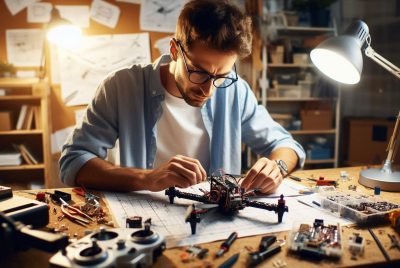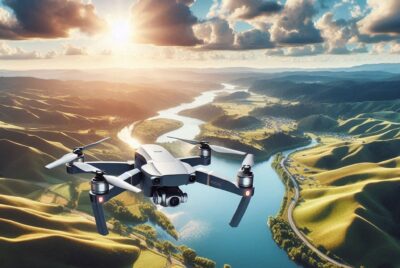Helicopter Drone: Revolutionizing Aerial Surveillance
*We may earn a commission for purchases made using our links. Please see our disclosure to learn more.
Helicopter Drone Advancements: Navigating the Future of Aerial Innovation
Drones have revolutionized the way we capture images, monitor environments, and even conduct search and rescue operations. Among the varying types of drones, the helicopter drone stands out due to it’s single-rotor design, which offers greater lift and longer flight times compared to their multirotor counterparts. These drones are particularly versatile, being able to hover precisely, take off and land vertically, and fly in more challenging conditions.
When considering a helicopter drone, prospective buyers need to focus on factors such as flight stability, control range, battery life, and payload capacity. These features determine the effectiveness of a helicopter drone in fulfilling its purpose, whether it’s for aerial photography, surveying, or industrial inspections. Enhanced stability and extended range can significantly improve performance, while longer battery life ensures the drone can operate over greater distances or for prolonged periods. The payload capacity is also crucial, as it affects the drone’s ability to carry additional equipment like high-resolution cameras or sensors.
In the process of selecting the right helicopter drone, it’s important to consider the intended use to ensure the chosen model meets the specific needs and demands of the tasks at hand. This consideration will guide buyers toward a drone with the right balance of performance features and cost.
After thoroughly investigating various models and considering their capabilities in relation to the needs of potential uses, I am now prepared to discuss which helicopter drones excel in providing efficient, reliable service in various applications.
Top Helicopter Drone Selections
In my experience, finding the right helicopter drone involves balancing between performance, durability, and ease of control. Whether you’re a hobbyist or a professional, the market has a variety of models to cater to different needs and skill levels. I’ve carefully examined the latest offerings and have distilled my findings into the list below, focusing on key features such as flight stability, camera quality, battery life, and additional functionalities that are important for a top-tier flying experience.
BUSSGO RC Helicopter
If you’re looking for an engaging and educational toy that doubles as an introduction to RC aviation, the BUSSGO Helicopter is a solid choice.
Pros
- Vibrant LED color options and demo mode captivate both kids and adults
- User-friendly with stable hovering and simple controls, ideal for beginners
- Hardy build quality paired with extra flight time ensures prolonged enjoyment
Cons
- Despite protective measures, collisions may still result in damage
- Learning curve exists for precise controlling, which may frustrate young pilots
- Indoor use is a limitation for those seeking outdoor flying adventures
The BUSSGO Helicopter impressed me with its radiant light display that transformed my living room into an aerial dance stage. Children would be absolutely fascinated by the 7+1 LED changing colors, and even adults could find themselves entranced by the helicopter’s night flights.
I found the altitude hold feature especially handy. I could pause mid-flight to catch my breath or plan my next maneuver, and the copter would wait patiently, hovering in place. For a beginner, the ease of use is a huge plus, allowing for a gentle introduction to the hobby of RC flight.
Durability is a concern with any flying toy, and I felt reassured with this model’s sturdy PVC frame. After a few minor crashes, which are inevitable when I’m at the controls, the helicopter only showed superficial scuffs. The modular batteries are also a welcome feature, extending playtime without a significant interruption for recharging.
SYMA S107H-E Helicopter
If you’re in the market for a beginner-friendly indoor helicopter, the SYMA S107H-E offers a solid flying experience with features that cater to new pilots.
Pros
- Impressive altitude hold for stable flights
- Sturdy alloy body stands up to crashes
- One-key takeoff/landing simplifies control
Cons
- Limited battery life
- Mainly for indoor use due to size and wind resistance
- Some users report durability issues after repeated use
Flying the SYMA S107H-E Helicopter is a real pleasure, especially if you’re just getting into the hobby. Its altitude hold capability is outstanding, keeping the helicopter steady midair and freeing you to focus on directional controls. Flying indoors is where this chopper shines; it zips around with ease, responding crisply to each command thanks to the gyro stabilizer.
The one-key takeoff and landing feature is a game-changer for beginners like me, who might otherwise struggle with these tricky phases of flight. It treats each flight as an opportunity to learn without the pressure, all thanks to this simple yet effective functionality.
The helicopter’s robust alloy body is reassuring. Even after a few unintentional encounters with the furniture, it continued to fly without a hiccup – a clear indication of its resilience. But keep in mind, the SYMA S107H-E isn’t just for kids. Its responsiveness and ease of control make it a fun pick for adult enthusiasts as well.
However, nothing is without its limitations. The battery life does leave something to be desired, lasting only long enough for a brief but enjoyable flight. A longer flight time would have been preferable. Additionally, while the helicopter is sturdy, its weight can only withstand so many crashes before wearing down, as some users have experienced.
This copter’s performance indoors is strong, yet this does somewhat limit its versatility as it doesn’t fare well against breezes, which is to be expected with any lightweight helicopter.
Cheerwing Mini Chopper
From my flights with the Cheerwing Mini Chopper, I believe it’s a solid choice for anyone looking to develop their flying skills with an entry-level helicopter drone.
Pros
- Responsive and stable flight experience
- Colorful flashing light adds to the fun of night flying
- Durable build quality that withstands minor crashes
Cons
- Short battery life limits flight sessions
- Requires practice to master control
- Small size can be hard to see at a distance
Having recently taken the Cheerwing Mini Chopper for a spin, I was immediately impressed by its nimbleness and stable hovering capabilities. The enhanced gyro system seems to work wonders for keeping flights steady, which is crucial for any novice pilot looking to get the hang of RC aviation. It’s compact enough to maneuver through indoor spaces without causing havoc – a huge plus in my book.
Outdoor flights were remarkably enjoyable as well, especially at dusk. The helicopter’s colorful lights not only added a cool factor but aided in visibility as I navigated between trees in my backyard. Despite its small stature, the Cheerwing punches above its weight with powerful, responsive controls that react to every subtle command.
The major drawback, though, was the flight time. I must admit, having just 5 to 7 minutes in the air was a bit of a downer, considering how addictive flying this chopper is. That said, the short bursts of joy were pure, unadulterated fun, challenging my dexterity and finesse with the controls. Patience and a careful touch are needed to truly excel with this model – skills that can undoubtedly transfer to larger, more complex drones.
For those looking to dive into the world of RC helicopters, my time with the Cheerwing has convinced me it’s an excellent starting point. It offers a hands-on flying experience that’s as educational as it is thrilling. Despite the battery life conundrum, it’s a small trade-off for the durability and performance on offer. Whether you’re weaving through obstacles, mastering the hover, or simply enjoying the LED light show, the Cheerwing is a dependable companion for both beginners and seasoned pilots craving a quick aerial fix.
BUSSGO RC Helicopter for Kids
I’d recommend this helicopter for anyone looking for a kid-friendly, durable RC toy that’s fun and educational.
Pros
- Colorful LED lights and demo mode entertain while flying.
- Stable hover and simple controls make it user-friendly.
- Two batteries included for extended flight times.
Cons
- May not challenge advanced users looking for nuanced control.
- Limited to indoor use to prevent damage or signal loss.
- Plastic body can feel less premium to touch.
Having just flown the BUSSGO RC Helicopter around my living room, I was struck by the vibrant display of lights. My niece found the flashing LEDs mesmerizing, and the demo mode, where it automatically does cool aerial stunts, added a distinct charm to our playtime.
The helicopter’s ease of use is another big plus. It just hovers there, in the air, awaiting my next move—very forgiving for a beginner. With the press of a button, I watched it take off and land without any hassle, and adjusting the speed settings added to the feeling of control.
Durably speaking, this little chopper proved to be quite resistant—I knocked it a couple of times against the furniture, and not even a scratch. The surprisingly long flight time allowed both my niece and me to practice without rushing to recharge every few minutes. It’s quite refreshing to have an RC helicopter that doesn’t require delicate handling.
The safety features should relieve any parent’s worries. While chasing it around the house, I felt assured knowing the blades spin at a safe speed, minimizing risk to both the kids and interior decors.
Educationally, this helicopter is a gem. As a flying enthusiast myself, I can see it sparking curiosity in engineering principles or even piloting. It’s not just a toy but also a fun teaching tool that could inspire a lifelong passion in a young mind.
Helicopter Drone: Buying Guide
When I’m in the market for a helicopter drone, I first consider its intended use. Whether it’s for aerial photography, racing or simply recreational flying, the purpose will significantly influence the features I need to prioritize.
Flight Time and Battery Life
I look for drones with longer flight times to enjoy extended sessions. Battery life is crucial, and I always check the average flight duration on a single charge.
- Standard Flight Time: 10 – 30 minutes
- Charging Time: 1 – 3 hours
Camera Quality
If I’m into photography or videography, camera specs become a priority. I ensure the drone has a high-resolution camera, stable gimbal, and offers live video streaming capability.
- Camera Resolution: 720p – 4K
- Stabilization: 2-axis or 3-axis gimbal
Helicopter Drone: Range and Connectivity
Control range indicates how far I can fly the drone without losing connection. Higher range translates to greater explorative freedom.
- Control Range: 100 meters – 5 kilometers
- Connectivity: Wi-Fi, Radio Frequency
Durability and Spare Parts Availability
I prefer drones built to withstand bumps and falls. A modular design with readily available spare parts makes maintenance easier.
- Material: High-grade plastic, carbon fiber components
- Parts Availability: Propellers, motors, batteries
Helicopter Drone – Price versus Features
I balance my budget against the features offered. While a higher price can indicate better quality or more features, it’s important to assess whether those features justify the cost in regard to my specific needs.
- Budget Drones: Limited features, good for beginners
- Professional Drones: Advanced features, high-quality camera and sensors
By considering these factors and comparing them objectively, I can choose a helicopter drone that best matches my requirements without being swayed by extraneous features or marketing hype.
FAQs About Your Helicopter Drone
In this section, I will address some common inquiries regarding helicopter drones, ranging from features and uses to recommended models and pricing.
1. What features should I look for in a camera-equipped helicopter drone?
For a camera-equipped helicopter drone, I suggest prioritizing image stabilization, high-resolution video capability, and a decent flight time. Features like GPS and obstacle avoidance systems are also important for smooth operation.
2. In what ways are military helicopter drones being utilized?
Military helicopter drones are used for surveillance, reconnaissance, and sometimes for carrying out precise strikes. They are valuable for their ability to hover, which enables more accurate intelligence gathering and support for ground troops.
3. What are some recommended helicopter drone toys for children?
For children, I recommend helicopter drone toys that are durable, have safety features like propeller guards, and are easy to control. The Syma S107/S107G is a popular choice due to its stability and beginner-friendly controls.
4. How do prices vary among different helicopter drone models?
Prices for helicopter drones can vary widely, from less than $50 for basic models to several thousand dollars for advanced systems. The cost typically reflects the drone’s size, camera quality, flight technology, and brand reputation.
5. Which mini helicopter drones with cameras are best for amateur photography?
Mini helicopter drones like the DJI Mini 2 or the Holy Stone HS160 Pro are ideal for amateur photography with their high-quality cameras, compact size, and ease of use. They offer a balance between affordability and the features required for capturing great aerial photos.







